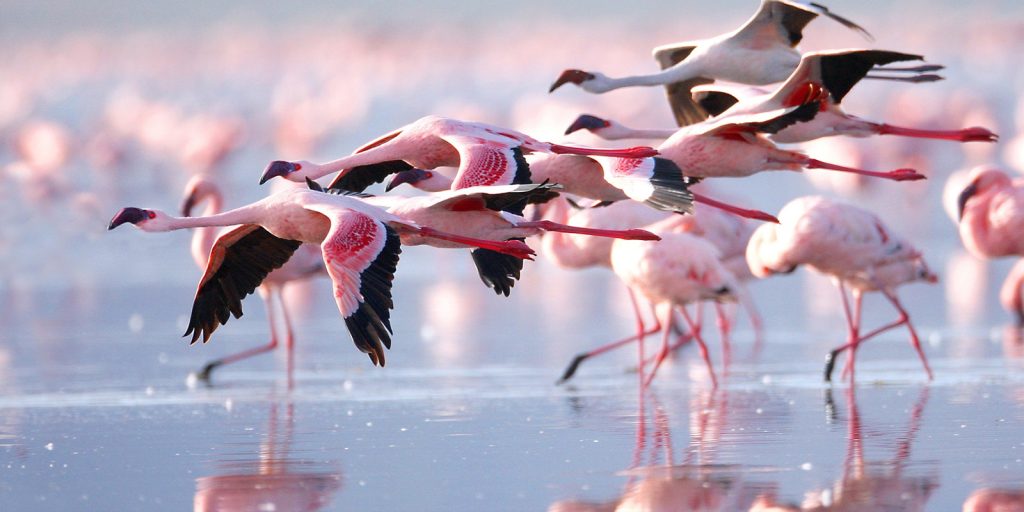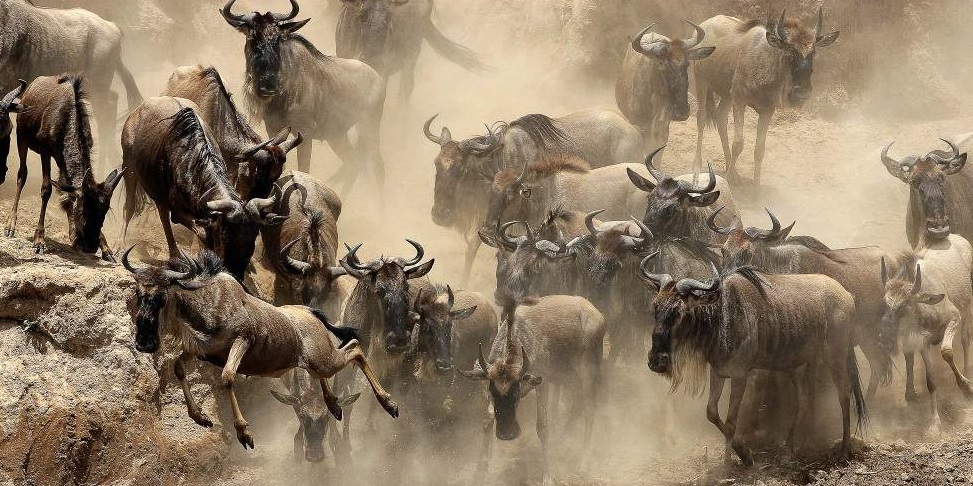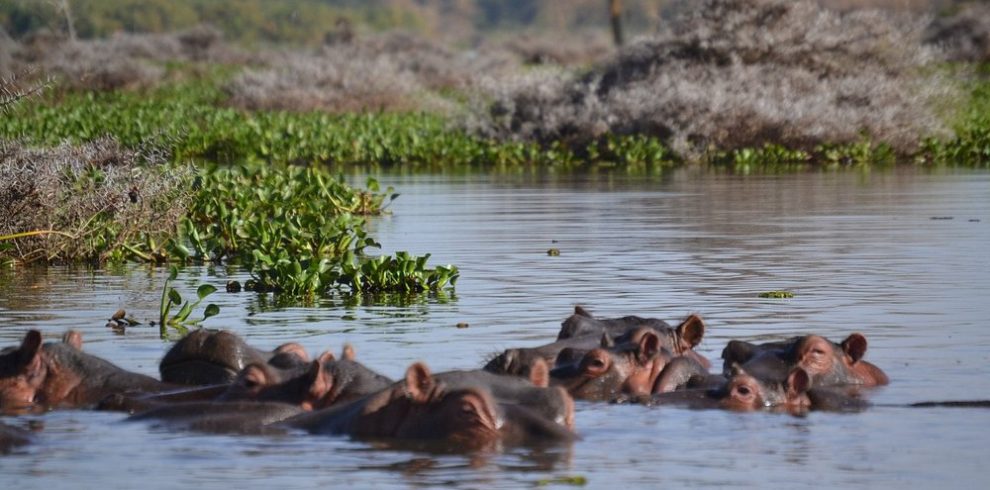Uncover fascinating facts about flamingos, from their striking pink color and social behavior to their feeding techniques and unique habitats around the world.
Without a doubt, flamingos are among the most easily recognizable birds in the world. Owning to their long graceful necks, attractive pink feathers and stilt like legs these birds are exhilarating to birding enthusiasts photographers and nature lovers. They are commonly related to foreign countries and beautiful sceneries when these creatures flock together to hunt, breed and live. But that makes flamingos one of the most interesting birds to watch and study because they are not just pretty birds, they are birds that perform awesome functions in their respective ecosystems.
Exodus safaris explores 5 fascinating facts about flamingos, regarding some external features, communication, feeding habits, and their role in the ecosystem. Flamingos don’t just have vibrant pink feathers and primarily red beaks; they are true wonders of evolution and of the world. If you are an avid bird watcher or you just want to learn more about some of the birds, then this guide will give you more insights into some of the most fascinating facts about flamingos – creatures of the bird species around the world.
1. Flamingos Get Their Color from Their Diet

This is one mystery that has puzzled scientists for many years: What really caused the pink or reddish colored feathers in the flamingos? These birds do not hatch with their cute pink feathers: flamingos are initially born covered with gray or white plumage. The red or pink feathering color in flamingos is greatly attributed by the foods these birds feed on in their natural setting.
Flamingos feed with a special type of feeding technique known as filter feeding where it feeds off plants, algae, crustaceans, fish among other animals around the shallow waters. Their color stems from carotenoids, a molecule they obtain from food and nourishment. These are naturally occurring brightly colored chemicals found in both algae and the invertebrates that flamingos feed on. They swallow them, and in their stomachs and intestines, the pigments are metabolized and assimilated by the flamingos’ bodies. These pigments accumulate in the feathers, the skin, and bill of the flamingo thus changing colour to pink or red.
They are also present in some other food products like carrots and sweet potatoes and that is why flamingos are pink in color. But not all flamingos look the same they are not painted in the same way and in the same colors. Only the adults are pink or red; though the intensity of their pink or red color may be fading based on diet or the specific species of flamingo. For instance, flamingos that feed on foods rich in carotenoids will have brighter colors than birds fed on other foods with low levels of carotenoids.
Notably, they are capable of regulating or even finding food sources rich in carotenoids in order to control the brightness of their plumage. The wild flamingos in areas where there is plenty of algae or brine shrimp are usually pink and red, whereas those in cages may be specially fed to obtain the desired color.
2. Flamingos Are Social Birds that Live in Large Colonies

There are a few interesting facts about flamingos that one should know, one of which is that they are very sociable birds. While flamingos are not strictly shy, they are most definitely social birds and are known to nest and feed in large colonies which can contain thousands, if not millions of flamingos. These colonies are however very important to flamingos for feeding, breeding and safety from predators.
Flamingos have a complex social organization and organization of groups and density of interactions within these colony groups is very high. Some birds are flamings; they move and dance in a coordinated manner. For instance, if one of the flamingos starts preening or engaging in courtship dancing, the rest join the dance, making the scene look picturesque. It is postulated that such coordination is useful for various reasons, including but not limited to increasing social bonding within the group.
Another interesting feature of the flamingo’s lifestyle is their penchant for roosting in a large colony. Flamingoes make their dumpy platform nests by molding mud into high structures in which they lay down their eggs. These nests are built often in close proximity to one another and in large colonies to discourage predators from getting to them easily. Aggregation in big numbers also minimizes the possibility of any eggs or individuals being picked and eaten by predation factors such as jackals, crabs and big birds of prey .
The increase in the numbers of birds also helps with foraging because the more the number of birds, the more the available food resources. A kind of collective foraging strategy in a colony of flamingos make them search for food in shallow waters. They employ long and slender snouts for filter feeding, and when many flamingos are on the hunt for food the availability of productive feeding zones is severally enhanced. The large group of the birds makes them feel safe since they know they cannot be attacked by a predator since there are many birds that the predator could have to deal with.
3. Flamingos Have Unique Feeding Habits

They are among the most interesting feeders in the entire bird community since they possess certain behaviors and structures that make them stand out. Their long and thin necks, tubes, and beak shape make them excellent divers with special adaptations to filter feed on tiny organisms from the water surface.
Another fascinating facts about flamingos is their feeding habits commonly referred to as filter feeding habits. Its long, downward curved bill is used to scoop water and mud from the shallow, often saline water of the lakes, lagoons or coastal margins in which the flamingos live. On the inside of their bills, there are specialized comb-like structures called “lamellae” that work as strainers. These plates enable the flamingo to filter out water and mud and they use their bills to scoop the water in search of tiny crustaceans, algae as well as other Forms of plankton.
The species feeding habits are interesting, especially those of the flamingo which feeds on some aquatic organisms. This they do by placing the point of their heads touching the water while they fossick around with the bills, filtering water as they move through it. This upside down feeding ability is due to their flexible neck structure and sharply pointed bills that enables them to immerse their heads into the water body without having the rest of their bodies soaked in water.
Although flamingos mainly filter-feed, they also employ another behavior known as mud probing. This is when they use their long sharp beaks to forage around submerged aquatic vegetation on the banks of wetlands in search of some buried food. Bills may also be driven by their food-seeking to disturb the bottom and turn over the sediment for the food hiding.
Another fact about the flamingos is that their feeding patterns depend on the availability of foods in the tim. Flamingos, especially in regions where food is plenty, will spend considerable time foraging and feeding in groups. But if the food there becomes depleted, these birds may need to move to another area that can provide better feeding grounds and this usually involves covering long distances in their quest for the best environment to feed.
4. Flamingos Exhibit Unique Courtship and Mating Rituals

The flamingo is also famed for its highly complex courtship displays which are perhaps among the most developed in the avian kingdom. These privileges serve a crucial importance in attracting intended partners for mating and guaranteeing the production of healthy offspring to the colony. The males also perform various movements and other displays so as to attract females that are in their mating periods.
Flamingos are also known to perform “a form of synchronized group dancing” which is another interesting aspect of them. Courtship in flamingos may involve processes of head-bobbing rocking, synchronized marching and mutual preening. These displays are parts of rather complex courtship performances where both possible partners have an opportunity to suss out each other and choose potential partners based on factors such as compatibility and fitness. The females may also be attracted by several display, which involves presenting colorful ornaments, and the males may also puff out their necks as a sign of supremacy.
It is also important to note that these flamingos display what is referred to as breeding bonds or pair bonds which usually exist for a specific breeding season. Once a male has successfully seduced a female, several pairs copulate, preen and build nests simultaneously. They engage in construction of a nest that is often made of mud and is located above water level in order to protect the eggs from floods. But, both innominate incubate and guard the eggs once laid as part of the reproductive activity.
However, in other species of flamingoes, for instance the lesser flamingoes, more complex actions are involved in the courtship. Males may perform “head flagging” – like raising their heads and swaying them from side to side. The other common motion is the synchronized “marching” in which all individuals in the colony conduct synchronized moves as a way of displaying for the females and asserting dominance over other males in the colony.
These courtship displays are not only colourful but are also important means of re-affirming social contacts within a group. Fluttering and swaying in unison, the flamingos also show how healthy they are to reproduce ensuring the survival of the progeny.
5. Flamingos Are Vital to Their Ecosystem

Flamingos assume significant functions in the ecosystems in which they reside. These animals act as water filtration systems, preserving the wetland ecosystems by preventing the growth of algae, small invertebrates and other microorganisms. Their eating patterns also play an essential role in controlling the growth of some algae species that may cause instability in the ecosystem.
Another way in which flamingoes impact wetland ecosystems is through seed dispersal and enhancing of plants growth in the are. When feeding, they disturb the substrate and so create a means by which to disperse plant seeds and so assist in the growing of plants in their ecosystems. It also helps to maintain the general health of a wetland in addition to helping other organisms that may depend on those areas for habitat and/or food sources.
Besides the importance of flamingos in the cycling of nutrients and distribution of seeds, there is the appreciation of the species as bioindicators. Flamingos are quite vulnerable to changes in water quality, level of pollution and loss of habitat. Observing the flamingo population is important to understand the current situation of wetlands and to potentially use it to improve conservation strategies.
Flamings indicate that an ecosystem is healthy and can support not only plant species but also animals or whatever species is fond of feeding on these plants. In this respect, flamingos not only look exquisite but also hold significant roles in their ecosystems as well.
Conclusion
To talk about flamingos, one of the most attractive and memoir birds in the global scale. From the crimson streaks to their feeding patterns to even the mating behavior and role in their environments, these birds are more than just the exquisite creatures that they are – they are the living, breathing components of the ecosystem without which the world cannot function as it should. Facts about flamingos make it clear that the bird is extremely hardy and able to survive in some of the harshest climates on the planet.
Whether one is attracted by their beauty, intrigued by their performance or fascinated by their role in the ecosystem, flamingos are wonderful animals that can be studied in many ways. They live in wetlands and shallow lakes and their importance cannot be overemphasized because of the role they play in the active conservation of the ecosystems .






